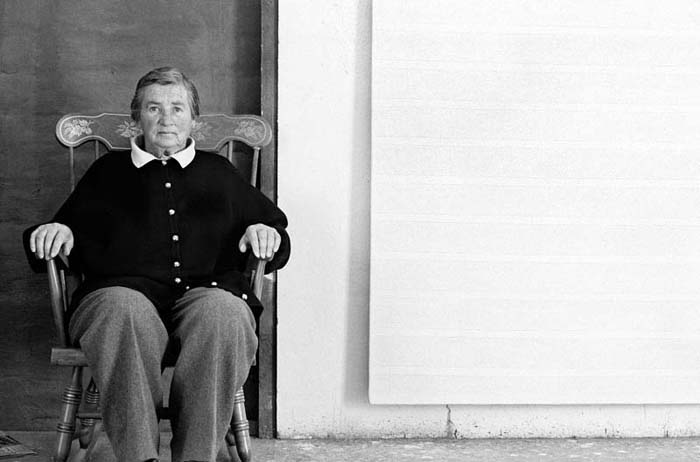For the New York Review of Books, Hilton Als writes about two new book on Agnes Martin, the biography “Agnes Martin: Her Life and Art” by Nancy Princenthal and a catalog edited by Frances Morris and Tiffany Bell for her traveling monographic exhibition. While Martin is the stuff of art world legend for leaving New York mid-career, Als delves deeper into her upbringing to make sense of the painter’s biography. Read Als in partial below, or in full via NYRB.
London. Late summer, 2015. The city’s habitual pearly gray daylight adds, it seems, an extra layer or patina of ardor and melancholy to the Canadian-born Agnes Martin’s extraordinary mid-to-late-career paintings—images made, for the most part, on square canvases measuring seventy-two inches, and filled with stripes of varying widths and hues that remain, twelve years after Martin’s death in 2004, at age ninety-two, some of the more significant creations about spirituality, beauty, and painting itself that modernism has ever known.
There’s a literary cast to Martin’s biography—the accidental and willed isolation of it—that reminds one of Christian carrying his burdens to the Wicket Gate, seeking enlightenment in John Bunyan’s religious allegory, The Pilgrim’s Progress, a text that exercised a considerable influence on Martin as a child. Born in Macklin, Saskatchewan, in 1912, she was the third of four children; her parents, Malcolm and Margaret Martin, farmed the vast, sometimes hard land. “It was so flat, you know, you could see the curves of the earth,” Martin recalled in Mary Lance’s intimate documentary, With My Back to the World (2002). “And when a train came into vision at nine o’clock in the morning, it was still leaving at noon…it took that long to get across the prairie.”
By the time she was three, Martin’s father had died, according to one of several accounts, from injuries suffered during the Second Boer War, which had ended in 1902. After his death, the apparently hard and embittered Margaret moved her family a few hours east to Lumsden, where the remaining Martins settled, for a time, with Robert Kinnon, Margaret’s widowed father. The Scotch Presbyterian farmer was the young Martin’s first experience of love. “I felt ‘first’ with my grandfather,” Martin said to her last dealer, Arne Glimcher, a memory he includes in his cumbersome but visually interesting book.1 Martin continued: “I’ve never felt first with anybody else…. He was a man who tried to be virtuous, really tried…. He influenced me tremendously.”
Kinnon read, with Martin, the Bible, The Pilgrim’s Progress, and other religious texts. Kinnon’s arm’s-length ministrations (he was not physically affectionate) did not so much act as an antidote to Margaret’s coldness as become the kind of distance his granddaughter could bear—and eventually emulate. But in Margaret’s presence Martin felt a sense of constant defeat and, because of her mother, was forced to take self-reliance to a punishing, perverse degree. When Martin was six she suffered from tonsillitis. The most Margaret could manage by way of comfort was to give her daughter money for the streetcar; she’d have to deal with it on her own. She did, and, after the operation was performed, returned home, again by streetcar, alone.
In 1919 the Martins joined Robert Kinnon in Vancouver, where Margaret supported the family by buying, renovating, and reselling houses. As close as Martin was to one brother, she avoided after-school walks home with her siblings; already she tended to avoid any form of social life that distracted her from examining the state of her own mind and that which it fixed on at the time: looking at pictures, drawing, and swimming. As an adolescent Martin developed into a strong swimmer and qualified for the Canadian Olympic swimming team. “The rigors and routines of competitive swimming and, perhaps most strikingly, its combination of ambition and solitude, are all habits Martin would sustain,” writes Nancy Princenthal in her strange book—a biography whose subject is so resistant to being known that Princenthal’s work feels more like a sketch than a completed portrait. Added to that is Princenthal’s Martin-like scrupulosity. (The design of the book doesn’t help, either, especially the index; the print is so tiny there you need a magnifying glass to read it.) She does not enliven the narrative with the distracting what-ifs and maybes that can and often do give biographies a little oomph.
Instead, she leans too heavily on the “telling” bits of information—the real-life metaphors—that she assumes make Martin more lifelike, especially when it comes to her fabled iconoclasm. To wit: “More than in any other organized athletic pursuit, swimmers, even when part of a team, are profoundly alone when they practice and compete.” Had Martin not been a woman, would her “profoundly alone” persona have generated so much interest? And so much useless and ultimately romantic speculation about what it might mean? Elizabeth Hardwick articulated the status quo’s reaction to certain independent women when she wrote of how negatively they were perceived, wandering about “in their dreadful freedom like old oxen left behind, totally unprovided for.”
Martin was having none of that. “We have been very strenuously conditioned against solitude,” she observes in her wonderful collection of writing. “To be alone is considered to be a grievous and dangerous condition…. I suggest that people who like to be alone, who walk alone will perhaps be serious workers in the art field.”2 Being an art worker was, she felt, a privilege, and one’s apprenticeship took as long as it took; art was not a race. “To live truly and effectively the idea of achievement must be given up,” she wrote in 1981 in an open letter to the Whitney Museum of American Art. Put unsentimental piety first, turn your back on the world, and get on with it.
*Image: Agnes Martin, portrait by Charles R. Rushton via slowmuse
